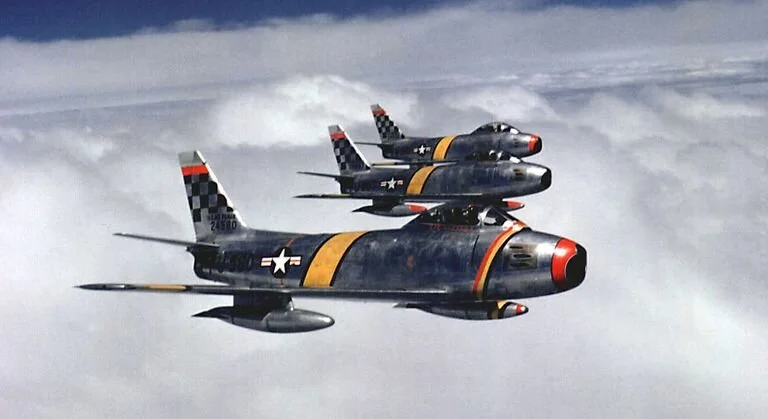A Love Letter to the F-86 Sabre
That Canadian-born farm boy up there? That’s my grandpa.
I grew up knowing fragments of his story: he was born in Mikado, Saskatchewan (population of 56 as of the 2006 Canadian Census), and didn’t speak a single word of English when he started school in the early 1940’s. When his sister, my great Aunt Betty, came home from school speaking another language, he cried because he couldn’t understand the words. Slowly but surely, he learned English and eventually refused to speak Ukrainian, because it wasn’t cool or very Canadian.
After school he joined the Royal Canadian Air Force and went on to fly “against” the Soviets during the Cold War. It was like Miracle, minus the hockey. Also, he was in France. My mother’s family grew up in the strange in-between that military life brings: they hopped from country to country, across Canada, France, and the United States, to wherever my grandpa’s work would bring him. After his service, he “retired” and joined United Airlines as a pilot, mainly flying routes out to Japan and Hawaii.
I learned about these stories mostly secondhand, through my grandmother’s retellings of her late nights with other pilots’ wives and the frustrations, fear, and adversity that came from being married to a fighter pilot. Sometimes, the night missions were long and the women were nervous, unsure of whether or not their husbands would come home the next day. Other times, these nights were just another day in the life. As a child, I knew the name of the plane my grandpa flew before I knew what type of car my family owned. It was the F-86 Sabre.
Because of the kind of child I was (see: lots of Star Wars and Top Gun) I had delusions of what the plane was like. Somehow, I managed to go years without ever realizing what the Sabre actually looked like. My brain naturally filled in the gaps with images of TIE fighters and F-14 Tomcats. But when I finally saw the Sabre outside of the Royal Military College in Kingston, Ontario, I was kind of disappointed.
Expectations vs. Reality: An F-86, F-15, and F-16 fly in formation during an airshow.
In my 12-year-old mind, the Sabre looked like someone had been shown a child’s drawing of what an airplane was supposed to look like and then told to build it blindfolded. The F-16, on the other hand, was what an interceptor aircraft was supposed to be: sharp angles, high speeds, the kind of airplane all the other planes hated in high school. In my mind, the F-86 was the Honda Civic of fighters: it wasn’t old enough to be retro-Spitfire cool, and it wasn’t new enough to look good. It was clunky. The wings were strange. And what was up with that inlet in the front?
As I’ve gotten older, I’ve come to finally appreciate the beauty of the F-86; not necessarily the aesthetic beauty of the aircraft, but the intrinsic beauty of its design and its long history. It was arguably the first plane to break the sound barrier in 1948, and was the vehicle of choice for Jackie Cochran, who was the first woman to break the sound barrier in 1953.
The badass herself, Jackie Cochran, in the cockpit of the Canadian Sabre with Chuck Yeager. Chuck was the first human to break the sound barrier in 1947 during level flight while strapped to the rocket-powered Bell X-1, which arguably doesn’t count as a ‘plane.’
It was a pioneer for the jet age and the first swept-wing aircraft, with a reported 10:1 victory ratio over Russian-built MiGs during the Korean War. It’s all-flying tail allowed the pilots more maneuverability compared to planes with a rudder or horizontal stabilizer. From an engineering perspective, it was a key stepping-stone in the evolution to the modern fighter.
So while it may not be an F-15, or 16, or 18, and while it may look like it was designed by someone who was told to make an engine fly, it was undoubtedly important worldwide: the jet served in over a dozen countries on every continent except Antarctica. Buzz Aldrin, Gus Grissom, John Glenn, and Gene Kranz - my NASA heroes of the Mercury and Apollo eras - all served in the F-86.
Gene Kranz next to his F-86 Sabre: “My Darling Marta,” named for his wife.
And most importantly, once upon a time, my grandpa flew this aircraft in the RCAF.
Col. Benjamin O. Davis Jr., commander of the 51st Fighter Interceptor Wing, leads a three-ship F-86F Sabre formation during the Korean War. US Air Force. Credit





